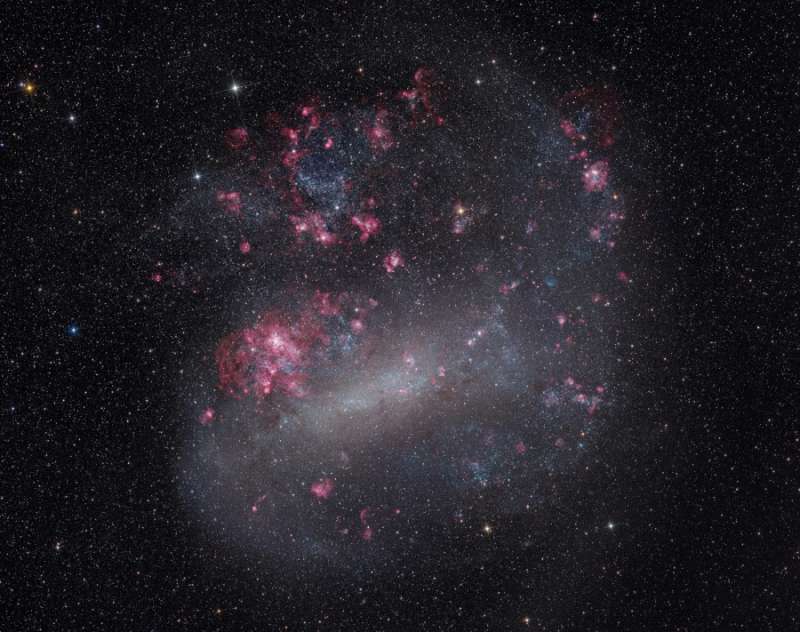Credit & Copyright: Marco Lorenzi
(Star Echoes)
Explanation:
A satellite galaxy of our own Milky Way, the Large Magellanic Cloud
(LMC) is an alluring sight
in dark southern skies and the constellation
Dorado.
A mere 180,000 light-years distant,
the LMC is seen in amazing detail in this
very
deep 4 frame mosaic of telescopic images,
a view that reveals the
Milky Way's
satellite to have the appearance
of a fledgling barred spiral galaxy.
The mosaic includes image data taken through a narrow filter
that transmits only the red light of hydrogen atoms.
Ionized
by energetic starlight, a hydrogen atom emits the
characteristic red
H-alpha light
as its single electron is
recaptured and transitions to lower energy states.
As a result, this mosaic seems spattered with
pinkish clouds of hydrogen gas surrounding massive, young stars.
Sculpted by the strong stellar winds and ultraviolet radiation,
the glowing hydrogen clouds are known as
H II
(ionized hydrogen) regions.
Composed of many overlapping clouds,
the sprawling Tarantula Nebula
left of center, is by far the LMC's largest star forming region.
The Large Magellanic Cloud is about 15,000 light-years across.
1999 2000 2001 2002 2003 2004 2005 2006 2007 2008 2009 2010 2011 2012 2013 2014 2015 2016 2017 2018 2019 2020 2021 2022 2023 2024 2025 |
Январь Февраль Март Апрель Май Июнь Июль Август Сентябрь Октябрь Ноябрь Декабрь |
NASA Web Site Statements, Warnings, and Disclaimers
NASA Official: Jay Norris. Specific rights apply.
A service of: LHEA at NASA / GSFC
& Michigan Tech. U.
|
Публикации с ключевыми словами:
LMC - Large Magellanic Cloud - H-alpha - HII region - star formation - Большое Магелланово Облако - БМО - области ионизованного водорода - Области звездообразования
Публикации со словами: LMC - Large Magellanic Cloud - H-alpha - HII region - star formation - Большое Магелланово Облако - БМО - области ионизованного водорода - Области звездообразования | |
См. также:
Все публикации на ту же тему >> | |
Мнения читателей [3]
